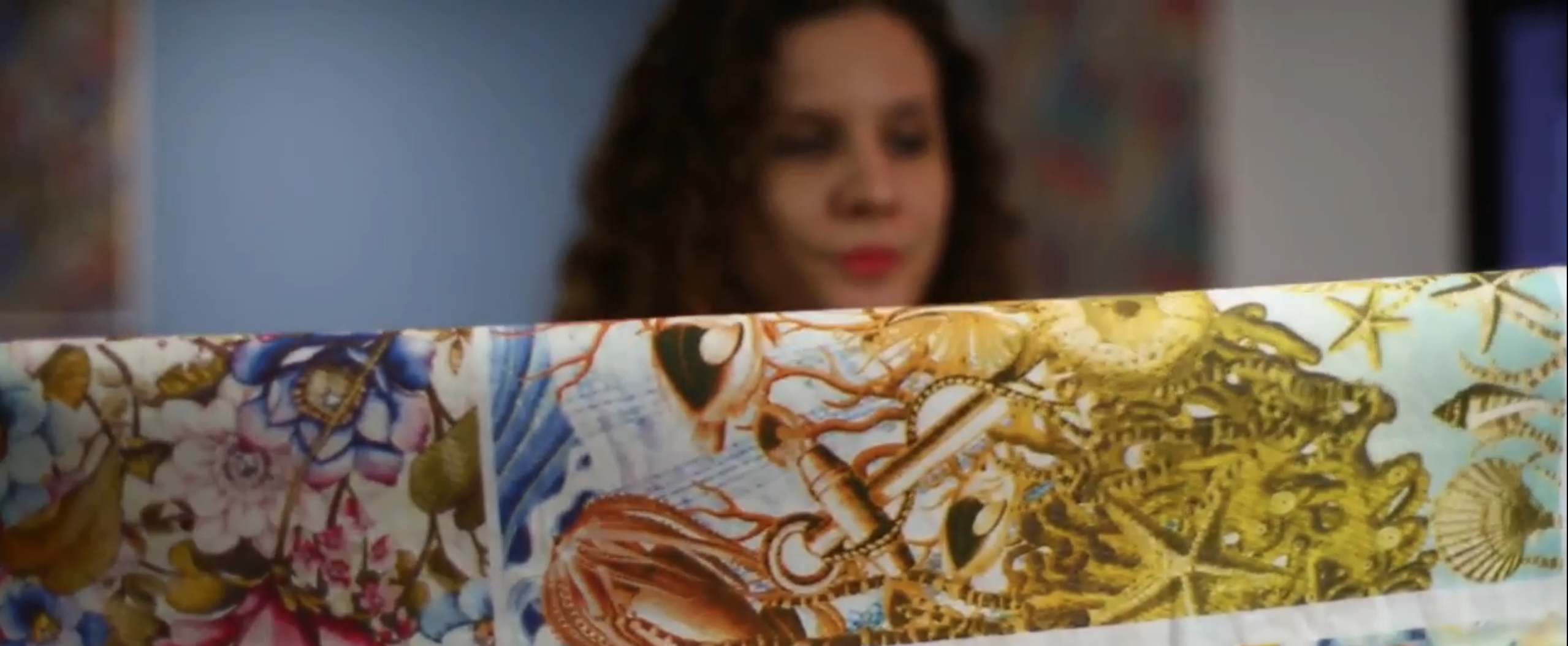As a digital textile printer, the quality of the print you produce is of utmost importance to your customers. In order to take full advantage from the high printing quality of digital textile print, you need an ink type that can deliver you that desired level of quality.
Reactive inks are a commonly used type of ink in the conventional textile printing industry. As a digital textile printer, of course, you would like to benefit from the advantages of reactive inks too. Are reactive inks suitable for digital textile printing and how do you choose the appropriate printing ink for your printing process and application?
What are reactive inks?
Reactive inks are very flexible in their usage and enable you to print on natural fibers, of which cotton is the most important one. On top of that, reactive inks can also be used when printing on silk, wool or viscose.
Reactive inks derive their name from the fact that the dye reacts with the chemicals in the printing paste in conventional printing. When the textiles are being steamed, this chemical reaction makes sure that the color molecules are bonded to the fiber.
Besides its flexible usage, there are two important advantages of using reactive inks. The first one is the high-quality of the colors produced by reactive inks especially when printing on cotton or viscose. And the second one is the high wash fastness. For top-level fashion brands in particular, high wash fastnesses are really important since this means that textiles can be washed often with limited loss of colors.

Why are reactive inks suitable for digital textile printing?
Especially among digital textile printers, reactive inks are very popular. It was the first type of ink that was developed for digital textile printing purposes. And not without reason. This type of ink is very suitable for digital textile printing since its molecules are very small which makes it easier for the droplets of ink to go through the nozzles of the inkjet printhead.
On top of that, reactive inks are very suitable for printing on natural fibers like cotton, which is a common used fabric type. For digital textile printers, it is therefore highly necessary to have a type of ink available that enables them to create high-quality prints with high wash fastnesses. Digital reactive inks provide them with that opportunity.
The main difference between reactive inks for digital and reactive printing paste for conventional printing lies in the way the chemicals that need to bind the color to the fabric are applied to the fabric. In conventional printing, those chemicals are part of the printing paste where also the color is in. But as these chemicals are a rather thick substance with large molecules, they cannot be sprayed with an inkjet nozzle that is needed to achieve enough resolution and detail. So the chemicals are applied in a separate process before printing, called pretreating.
The substance that is used during pretreatment consists of all the chemicals needed to later bind the color molecules to the fabric. Applying pretreatment is mostly done by padding the fabric through a chemical bath in front of a stenter (to dry the fabric). Some users prefer screen coating for it. The chemicals stay really on the top of the fabric then, so all the colors will stay there too. This is for example attractive for printing very bright neckties, where color brilliance is important and penetration not at all.
When to use reactive inks and when to use other inks?
Nowadays, you can print with nearly every type of ink on a digital textile printer. But how to determine the right ink type for your textile print application? If it is a 100% cotton or viscose, then reactives are the preferred solution. In conventional printing often pigments are used, mainly because of price, with the trade off of less vibrant colors.
If you want to print silk or wool fabrics then you have to take the application of the fabric into consideration. Is it a fabric that will be washed often and of which the quality should not decrease too fast because of this? Then reactive inks are the best choice for your application. However, if you’re printing fabric that requires really high quality and vibrant colors but will not be washed very often (like scarfs or ties), then acid inks are more suitable for your application. Do you want to learn more about all the different types of ink available? Find the type of ink that best matches your textile printing goals:

Challenges of reactive ink in digital textile printing
Although reactive inks provide many advantages for digital textile printers, there has been one thing digital printers have been struggling. That challenge is to create the ultimate deep black. When digital textile printing was introduced, its black looked more like anthracite grey. The goal has always been to develop a darker kind of black.
As a digital ink supplier, SPGPrints has always been busy creating an ink that could produce a more intense black. In doing so, SPGPrints created special digital textile Reactive Black inks for both types of reactive colors that are used in conventional printing: VS ink and MCT ink. The difference can be found in the chemistry of the inks. VS ink, or Vinyl Sufone ink, is a type of ink that produces powerful colors but is more difficult to maintain stable in the washing and steaming process. If you don’t have enough control over your steaming process, the black VS ink can turn out brown or even pink. MCT ink, or MonoChlor- Triazine ink, is easier to use than VS, but it produces a little less deep black colors.
Our black VS ink is the most intense black reactive ink out there. For digital printers not wanting to use VS ink, we’ve also created a black MCT ink that is way deeper and intenser than MCT inks used to be. When choosing between these two types of ink, you should first ask yourself if you’re able to maintain VS inks in your current workflow and if you’re willing and able to put in the extra effort to produce a deeper kind of black. If not, our black MCT ink is enabling you to produce a nice, deep black color too without requiring you to have optimal control of your workflow.
Unrivaled quality and color density with digital inks
The type of ink you use impacts the quality of your prints. Therefore, we believe that you should only use the best inks available for your printing technique. Because of the large variety of inks available, it can be difficult to choose which one best fits your production process.
At SPGPrints we produce all types of inks for digital textile printing. Our digital inks offer digital textile printers unrivaled quality,color density and ensure reliable performance.
Curious what digital textile printing and digital inks, in particular, can do for the quality of your prints? All different types of ink are highlighted in our free Ink Selection Guide. Learn how you can choose the perfect ink for your printing process and discover how the pricing of inks is determined. Download it here:







